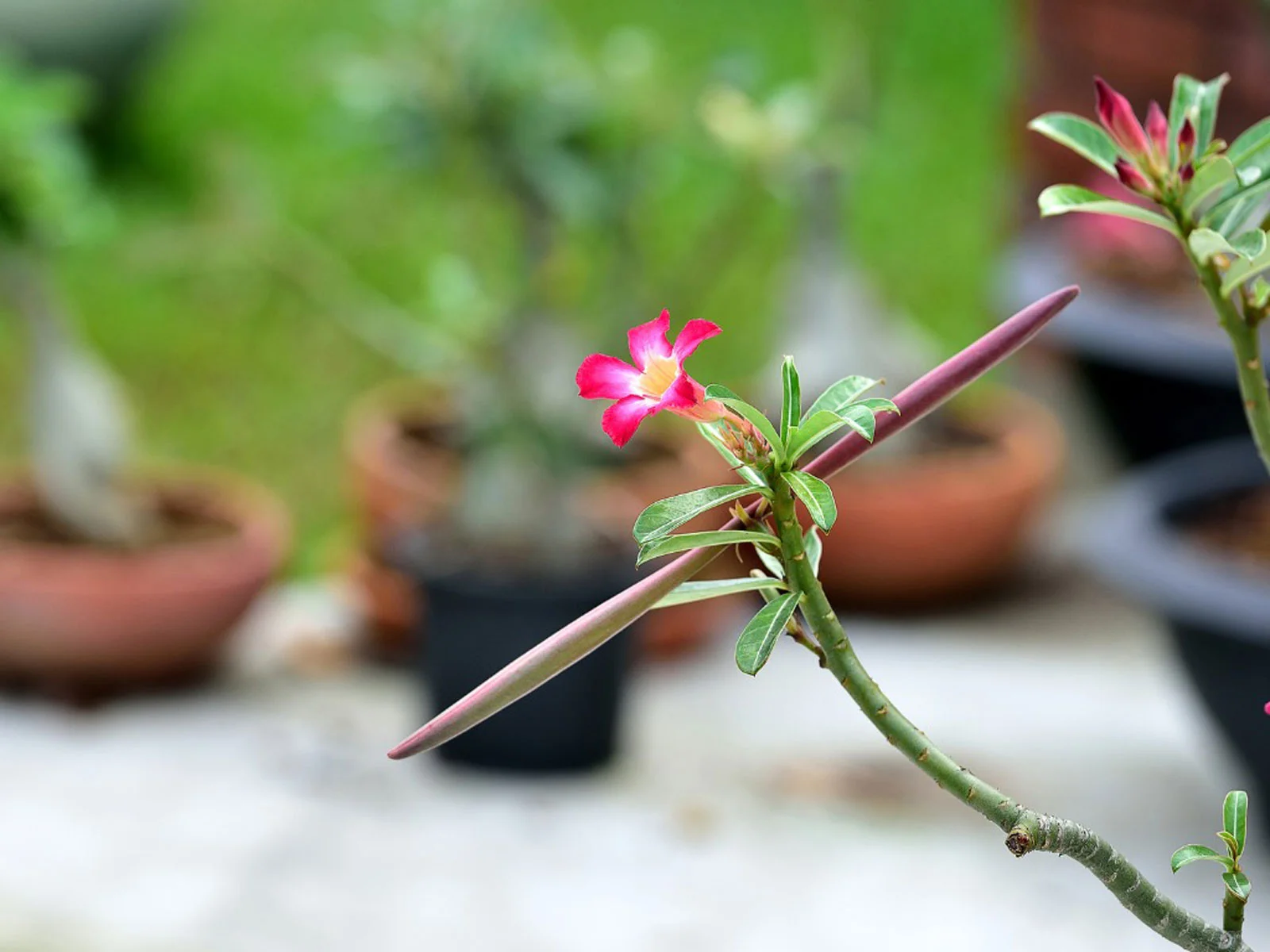Home>Gardening News and Trends>Latest News>What Insects Live In The Desert


Latest News
What Insects Live In The Desert
Published: December 3, 2023
Discover the latest news about insects that thrive in the desert ecosystem. Explore the fascinating adaptations and behaviors of these resilient creatures.
(Many of the links in this article redirect to a specific reviewed product. Your purchase of these products through affiliate links helps to generate commission for Chicagolandgardening.com, at no extra cost. Learn more)
Table of Contents
Introduction
The desert is a harsh and unforgiving environment, characterized by extreme temperatures, sparse vegetation, and limited water sources. Despite these challenges, it is a thriving ecosystem that supports a diverse array of life, including insects. In fact, insects are one of the most abundant and successful groups of organisms found in the desert.
Desert insects have evolved a remarkable set of adaptations that enable them to survive in such inhospitable conditions. From specialized body structures to behavioral strategies, these adaptations allow them to withstand the scorching heat, scarce resources, and frequent droughts that are characteristic of desert environments.
There are various types of insects that have managed to adapt and flourish in the desert. From hardy beetles to agile grasshoppers, each species has evolved unique strategies to cope with the challenges of the arid landscape. These insects play crucial roles in the desert ecosystem, from pollination and seed dispersal to providing food for other organisms.
Despite their significant contributions, desert insect populations face several threats. Climate change, habitat loss, and pesticide use are just a few of the factors that pose a risk to these vital creatures. To protect and preserve their populations, conservation efforts and ongoing research are necessary.
In this article, we will explore the fascinating world of desert insects. We will delve into their remarkable adaptations for survival, discuss the various types of insects found in the desert, explore their roles in the ecosystem, examine the threats they face, and highlight the importance of conservation and research in safeguarding their future.
Characteristics of Desert Insects
Desert insects possess a unique set of characteristics that enable them to thrive in the harsh and arid desert environment. These characteristics have evolved over time, allowing them to adapt and survive in conditions where few other organisms can.
One of the key characteristics of desert insects is their ability to conserve water. Water is a scarce resource in the desert, and insects have developed various mechanisms to minimize water loss. Many desert insects have a waxy or thick cuticle on their exoskeleton, which acts as a barrier to prevent water from evaporating. Additionally, some insects are capable of closing their spiracles (tiny openings on their bodies that allow for respiration) to reduce water loss through transpiration.
Another important characteristic is their ability to tolerate high temperatures. Desert insects have developed ways to regulate their body temperature and minimize heat absorption. Some species have evolved behavioral adaptations such as hiding in burrows or seeking shade during the hottest parts of the day.
In addition to these physiological adaptations, desert insects often have specific morphological features that aid in survival. For example, many desert insects have long and slender bodies, allowing them to move quickly and efficiently across the sandy terrain. Some insects also have elongated legs, which help them navigate the uneven desert surface.
Furthermore, desert insects have developed remarkable sensory capabilities. Their antennae are often highly sensitive, allowing them to detect subtle changes in their environment. This helps them locate food, mates, and water sources in the vast desert landscape.
Overall, the characteristics of desert insects reflect their incredible ability to adapt and survive in extreme conditions. Their unique adaptations and strategies ensure their ability to find resources, withstand harsh temperatures, and navigate the challenging desert terrain.
Adaptations for Survival in the Desert
Surviving in the desert requires special adaptations, and desert insects have developed a range of remarkable strategies to overcome the challenges posed by this harsh environment. These adaptations allow them to thrive where others struggle to survive.
One of the most crucial adaptations is the ability to minimize water loss. Desert insects have evolved various mechanisms to conserve water in their bodies. Some species have a waxy or thickened cuticle on their exoskeleton, which acts as a barrier to prevent water loss through evaporation. Additionally, many desert insects are capable of closing their spiracles, reducing the amount of moisture lost through transpiration.
Another important adaptation is the ability to withstand extreme temperatures. Desert insects are equipped with physiological and behavioral mechanisms to regulate body temperature. Some insects have adapted dark body colors, which aids in thermoregulation by absorbing heat from the surroundings. They may also exhibit behavioral adaptations, such as seeking shade during the hottest part of the day or burrowing into the cool sand.
Desert insects have also developed specialized feeding habits to cope with the limited food resources in the arid environment. Some species feed on plants or flowers that have adapted to survive in the desert, while others are opportunistic scavengers or predators, feeding on other insects or small animals.
In addition to these adaptations, desert insects have evolved unique locomotion strategies to navigate the challenging desert terrain. Some insects, like beetles and ants, have sturdy legs and thick exoskeletons that allow them to move through the sand with ease. Others, like grasshoppers, have long and powerful hind legs that enable them to make impressive leaps over the desert landscape.
Furthermore, desert insects possess remarkable sensory adaptations. Many species have highly developed antennae, which are finely tuned to detect chemical cues in their environment. This helps them locate food, mates, and potential predators in the vast and sparsely populated desert.
Overall, the adaptations of desert insects reflect their remarkable ability to survive and thrive in one of Earth’s most challenging environments. These adaptations ensure their ability to find water, regulate body temperature, locate food, and navigate the desert landscape.
Types of Insects Found in the Desert
Desert ecosystems are home to a wide variety of insects, each uniquely adapted to thrive in the arid conditions. These insects display incredible diversity in their morphology, behavior, and ecological roles. Let’s explore some of the most common types of insects found in the desert.
One prominent group of desert insects is beetles. Beetles have a hard exoskeleton and can be found in a range of sizes and shapes. Some species, like the darkling beetle, are well-adapted to the desert environment with their ability to survive for long periods without water. Other beetles, such as the blister beetle, have specialized defensive mechanisms and chemical adaptations.
Ants are another common type of insect found in deserts. They have well-developed social structures and exhibit highly organized behavior. Desert ants are equipped with long legs and strong exoskeletons, which enable them to navigate through the sandy terrain efficiently. They play crucial roles in seed dispersal and nutrient cycling in arid ecosystems.
Grasshoppers and locusts are known for their ability to leap long distances and their characteristic chirping sound. These insects have strong hind legs for jumping and specialized mouthparts for feeding on desert vegetation. Their rapid reproductive cycle allows them to take advantage of short periods of favorable conditions, such as after a rare rainfall, when desert plants are able to sprout.
Moths and butterflies are also represented in desert ecosystems. These insects undergo metamorphosis and have colorful wings that aid in camouflage or deter predators. They play a vital role in pollination, helping to ensure the survival of desert plants and contributing to the overall biodiversity of the ecosystem.
Spiders are arachnids commonly found in desert environments. They have adapted to the harsh conditions by developing strategies to conserve water and survive on limited food sources. Desert spiders, such as the trapdoor spider, construct burrows or webs to ambush prey and protect themselves from extreme temperatures.
Lastly, desert bees and wasps are important pollinators in arid ecosystems. They have unique adaptations to tolerate high temperatures and aridity, such as specialized water-conserving behaviors. Desert bees, like the solitary digger bee, are equipped with dense hair on their bodies, which helps them collect pollen and reduce moisture loss.
These are just a few examples of the diverse range of insects found in desert environments. Each species has unique adaptations and ecological roles, contributing to the intricate web of life in the desert ecosystem.
Role of Insects in Desert Ecosystems
Insects play vital roles in desert ecosystems, contributing to the overall health and functioning of these unique environments. Their diverse ecological roles have a significant impact on both the flora and fauna of the desert. Let’s explore some of the key roles that insects play in desert ecosystems.
One of the primary roles of insects in the desert is pollination. Many desert plants rely on insects, such as bees, butterflies, and moths, to transfer pollen from one flower to another, enabling fertilization and the production of seeds. This mutualistic relationship between insects and plants ensures the survival and reproduction of desert plant species.
Insects also contribute to seed dispersal in desert ecosystems. Some insects, like ants and beetles, feed on seeds and fruits and then disperse them as they move around. This aids in the colonization and distribution of plant species in the arid landscape, helping to maintain biodiversity and ecosystem resilience.
Furthermore, insects serve as a crucial food source for a variety of other organisms in the desert. Many birds, reptiles, and mammals rely on insects as a primary or supplemental food source. Insects are an essential part of the food web, serving as prey for predators and contributing to the overall balance of the ecosystem.
In addition to their direct ecological roles, insects also contribute to nutrient cycling in the desert. Decomposer insects, such as beetles and ants, break down organic matter like dead plants and animals, releasing nutrients back into the soil. This process contributes to the overall fertility of the ecosystem and supports the growth of desert-adapted plant species.
Insects also provide important ecosystem services in the desert. For example, bees are key pollinators not only for native plants but also for cultivated crops that play a crucial role in local economies. By facilitating crop pollination, insects contribute to the successful production of food and other agricultural products in desert regions.
Overall, insects play a vital role in the functioning and ecological balance of desert ecosystems. Their contributions to pollination, seed dispersal, nutrient cycling, and as a food source for other organisms are essential for the overall health and survival of the desert ecosystem.
Threats to Desert Insect Populations
Desert insects face numerous threats that put their populations at risk. The fragile and unique nature of desert ecosystems, combined with human activities and environmental changes, have a profound impact on insect populations. Let’s explore some of the key threats that desert insects face.
Habitat loss and degradation are major threats to desert insects. The expansion of urban areas, agriculture, and infrastructure development often leads to the destruction of desert habitats. Desert insects rely on specific plant species and microhabitats for food, shelter, and reproduction. When these habitats are destroyed or fragmented, populations can rapidly decline.
Climate change is also a significant threat to desert insect populations. Rising temperatures, altered rainfall patterns, and extreme weather events can disrupt the delicate balance of desert ecosystems. Insects that have finely tuned adaptations to specific temperature and moisture conditions may struggle to cope with rapid changes, leading to declines in population size and even local extinctions.
Another threat to desert insects is pesticide use. Insecticides, herbicides, and fungicides used in agriculture and pest control can have unintended consequences on non-target organisms, including desert insects. These chemicals can accumulate in the environment, affecting insect populations directly or indirectly through the disruption of food webs.
Additionally, invasive species pose a threat to desert insect populations. Non-native plant species, animals, and insects introduced to deserts can outcompete native species for resources or prey upon them, disrupting the delicate ecological balance. Invasive species can also introduce diseases or parasites to which native desert insects have no natural defenses.
Human disturbance and recreational activities in desert areas can also adversely affect insect populations. Off-road vehicle use, trampling, and the collection of specimens for commercial purposes can disrupt habitats and disturb insects during critical life stages.
Fragmented and isolated desert ecosystems face additional threats due to reduced gene flow and the increased risk of genetic bottlenecks. These factors can lead to a loss of genetic diversity within insect populations, making them more susceptible to environmental changes and reducing their ability to adapt and persist in the face of future challenges.
It is crucial to recognize and address these threats to desert insect populations to ensure the preservation of these unique and valuable ecosystems. Conservation efforts, habitat restoration, environmentally-friendly farming practices, and public awareness are essential in protecting the delicate balance of desert ecosystems and safeguarding the diverse array of insects that call them home.
Conservation and Research Efforts
Recognizing the importance of desert insects and the threats they face, conservation and research efforts are essential for their protection and the preservation of desert ecosystems. These efforts focus on understanding insect populations, implementing conservation strategies, and raising awareness about their ecological significance. Let’s explore some of the key conservation and research efforts dedicated to desert insects.
Research plays a vital role in understanding the ecology, behavior, and life cycles of desert insects. Through field studies, scientists can gather information on population dynamics, habitat requirements, and the impacts of human activities on insect populations. This knowledge provides a foundation for the development of effective conservation strategies.
Habitat preservation and restoration are crucial components of conservation efforts for desert insects. Protecting intact habitats and preventing further habitat loss are essential. Efforts are also made to restore degraded desert areas, including the establishment of native plants that provide essential resources for insect populations.
Community engagement and education programs raise awareness about the value of desert insects and the need for their conservation. These programs aim to foster appreciation and understanding of the role insects play in desert ecosystems and promote responsible behaviors to minimize human impacts on their habitats.
Insect breeding programs and captive rearing initiatives are used for conservation purposes. These programs help ensure the survival of endangered or threatened desert insect species by maintaining viable populations in controlled environments. If appropriate, individuals may be reintroduced into suitable habitats to bolster wild populations.
Monitoring and surveillance programs track population trends and detect any alarming changes in desert insect populations. This data helps researchers and conservationists identify areas of concern and take timely action to mitigate threats such as habitat destruction, climate change, or invasive species.
Collaboration between scientists, policymakers, land managers, and local communities is essential for the success of conservation efforts. By working together, these stakeholders can develop and implement effective strategies for protecting desert insects and their habitats.
Incorporating sustainable agricultural practices is also critical. Minimizing the use of pesticides and promoting organic farming methods can reduce the impact on beneficial insect species and provide healthier environments for both insects and farming systems.
Conservation organizations and government agencies play a crucial role in supporting and coordinating efforts to conserve desert insects. By providing funding, expertise, and policy support, these entities help ensure the long-term survival of these valuable and often understudied insect populations.
By combining research, conservation actions, public outreach, and policy support, ongoing efforts are being made to safeguard desert insect populations and the fragile ecosystems they inhabit. With continued dedication and collaboration, it is possible to mitigate the threats they face and ensure their continued existence for future generations.
Conclusion
The desert is a challenging and unique environment that is home to a diverse array of insect species. These insects have evolved remarkable adaptations to survive and thrive in the harsh conditions of the desert. From conserving water to tolerating high temperatures, their abilities to adapt and persist are truly awe-inspiring.
Desert insects play crucial roles in desert ecosystems, such as pollination, seed dispersal, nutrient cycling, and serving as a vital food source for other organisms. They contribute to the resilience and biodiversity of these fragile environments, making their conservation imperative.
However, desert insects face a range of threats that put their populations at risk. Habitat loss, climate change, pesticide use, invasive species, and human disturbance all contribute to the challenges they face. Efforts to protect and preserve their populations involve research, habitat preservation and restoration, community engagement, monitoring, and sustainable practices.
The conservation and research efforts dedicated to desert insects are vital in safeguarding these unique and valuable ecosystems. By raising awareness, implementing effective conservation strategies, and involving multiple stakeholders, we can ensure the long-term survival of desert insects, promoting the overall health and stability of desert ecosystems.
Preserving these remarkable creatures and their habitats goes beyond the intrinsic value of these ecosystems; it also has practical implications for human well-being. Desert insects contribute to essential ecosystem services such as pollination, seed dispersal, and nutrient cycling, benefiting not only the plants and animals of the desert but also our agricultural systems and society as a whole.
Through our collective efforts, we can protect the delicate balance of desert ecosystems, ensuring that these insects continue to thrive and inspire us. By embracing sustainable practices, educating others, and supporting research and conservation initiatives, we contribute to the preservation of the intricate web of life in the desert and play our part in protecting one of the world’s most unique and fascinating ecosystems.






